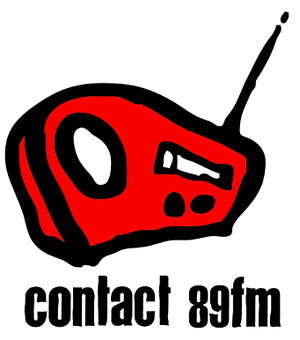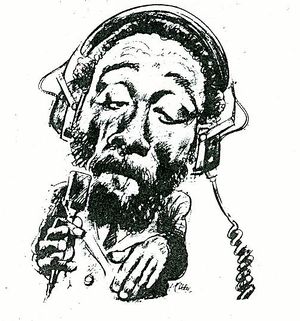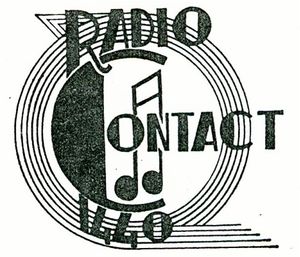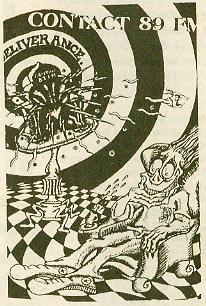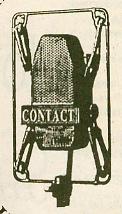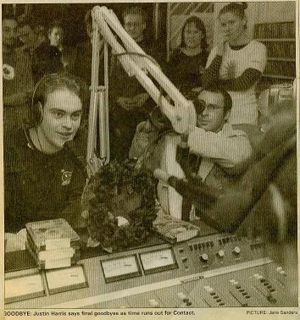Contact FM
Contents
[hide]History[edit]
Contact had its beginnings in 1974 as "The Campus Communications Club", formed by David Kinzett, Duncan Stuart and Ken Kilpin, with the aim of starting a radio station. For the first two years their only capability was to "broadcast" during Orientation week to the University of Waikato's student cafe's, in-house only (i.e., to Oranga, downstairs Oranga, the Teachers College cafeteria and the quad area in front of the Cowshed). In 1977 the station went "on-air" for the first time using an ex-Canadian Airforce AM transmitter, bought for $250 from Valentines (later known as Doyles Army surplus). From this time it went under the moniker "Radio Nyllewell", named after the Nyllewell Republic (an area of the University comprising Oranga and the Cowshed), which in turn was named after the universities vice-Chancellor, Don Llewellyn (Nyllewell is his surname spelt backwards). However, Radio Nyllewell could still broadcast only during O-weeks, and initially the Broadcasting Tribunal (enforced by the post office) would not allow the station to broadcast any advertisements. The station did 'pipe' music into the campus cafeterias while not "on air". At this time broadcasts were on the on 1450 kHz band (moving to 1440 kHz from 1978). In 1977 the studio was located in the top floor of K block, in K3.09, at the University. From 1978 the station broadcast from downstairs Oranga, changed its name to "Radio Contact", and in 1981 moved to the Cowshed. It was called 'Contact' as a name starting with "C" was needed to fit in with the last letter of the call-sign "ZL1XC". It was not until 1983 that Radio Contact began broadcasting longer hours, and throughout the year. However, this had the effect of the station having to play advertising from 1984, although it was ensured that advertisers had no say on the music playlisted.In 1985 Max Christoffersen became station manager. Throughout 1985 Christoffersen was dedicated to building the culture of Contact 1440 1XC around a semi-professional station sound and wider playlist. It would be a radical shift away from the early AM days and the 'Short Term Broadcast Authorisations' (STBA's), where student stations broadcast with AM licenses for 28 days back-to-back throughout the academic year. The first attempt at playlisting was introduced by Selwyn Collier and the cataloging of Contact's large music collection was done by hand, under the watch of Heather Staley. Production work for station IDs was undertaken by John Pattenden (who would later build The Fridge). There was still free choice for the announcers, but Collier was increasingly defining a station sound through playlisting that meant announcers picked up programmed records/tracks from the catalogue as part of each shift.
Dedicated specialist shows were slowly introduced. The station's daytime programming was alternative rock, with a dedicated New Zealand music 'quota' guaranteed through Collier's playlisting. The station also introduced accommodation and movie guides and broadcast Student Job Search vacancies directed at students. Meanwhile, the station had to get more organised with rostering student announcers on-air with 47 volunteers in total working at Contact 14401XC in 1985. There was no automation at the station, with Contact FM being completely vinyl driven, requiring student announcers to be in studio to keep Contact-FM on-air. Critically, the station's playlist was widening as Contact's links with record companies and new faces with dedicated musical interests became involved with the station. News stories were compiled by students for local bulletins, while programmes supplied by National Radio featured interviews with university academic staff. The aim for all the students involved in 1985 was to be on FM in 1986. That was going to require new equipment and the buy-in from the Waikato Students' Union to fund the new gear.
The University of Waikato's Facilities Management division were also required to buy-in to the new FM station and agree to house the new transmitter on the library roof. This required rigorous testing to ensure there was no Radio Frequency Interference from the university's science labs that were in direct line of sight of the new transmitter site.
In late 1985, after a storm, the AM mast that was then on top of Oranga blew some of its stays and was leaning at a dangerous angle. Christoffersen had lobbied the Waikato Student Union (WSU) throughout 1985 advocating for the shift to FM. The cost of repair of the damaged mast and upgrading the AM transmitter was too costly. As such, the storm damage created an opportunity to leverage for the move. The station closed down early in late 1985 due to the storm damage. The WSU Executive agreed to the shift and Contact AM 1440 1XC, and its first broadcast on FM was in February 1986.
Most of the students involved in 1985 stayed on as Contact still had a long way to go to become what the Waikato Times John Drinnan would later describe as, 'one of the most professional amateur stations around."
In 1986, the FM transmitter was imported from Italy at a cost of $15,000, but due to late delivery and technical issues, the mast was originally located on the WSU building; the bolt holes are still visible today on the back of the Cowshed studio. Once the connections for the STL phone-line links were established and working between the Cowshed and the library, the transmitter and mast were then moved to the top of the library in May 1986. Radio Engineer Vern Talbot was central to all of the station's early technical work and ensuring the station met its 100 Watt student radio (Schedule 7) license conditions. The transmitter stayed on top of the library throughout its broadcast life. This made the antenna the highest metal object in the area, and twice between 1994 and 1996 the antenna was struck by lightning and the studio desk exploded.
Central to Contact's FM future was the ability to gain advertising. Glen Cooper was the station's first Advertising Manager and he quickly became an important member in the station's development, helping Contact bank $28,000 in its first year on FM, up from $1500 in its last year on AM. The end of year accounts validated the move to FM and it meant station plans for the future were viable, including building the The Fridge production studio, which could now be done with surety the following year.
Contact was the last university student station to move to FM. Shortly afterwards, all six FM student stations were promoted together as part of the Student Radio Network (SRN - later B-Net), which was designed to provide student centered advertising packages nationwide to national clients.
The profile of the station was increasing as Christoffersen wrote weekly columns in Nexus. However, Christoffersen had created controversy by widening Contact's playlist. The introduction of dedicated programmes of women's music, acoustic music, reggae, and Christian music was not welcomed by all. Particularly controversial was the launch of the Axe Attack, hosted by Johnny Brookes. At other student stations, heavy metal was not played. Christoffersen recalled a Wellington student radio conference where the WEA Record rep Jimmy Hendricks asked if anyone would play metal bands. None of the other campus Programme Directors (PDs) raised their hands. Christoffersen remembered heated debate in the discussions with other student PDs that followed; 'How could Contact play that "misogynistic music?" "Because no one else was...", Christoffersen replied. The Axe Attack became one of Contact's most listened to shows and became a symbol of the way different student stations broadcast to their own unique audiences. In a National Radio Documentary about NZ student radio broadcast in 2015, Christoffersen stated; 'Contact 89FM found its voice with the specialist programmes'. The move towards wider music styles and genres outside traditional alternative rock created heated debate around the university campus, becoming the focus of several of the Nexus Contact-FM columns in 1986. Over time, all student stations moved into more varied and diverse music styles.
Much of the ground work established during 1985/86 set the culture and musical path for Contact's future. Station branding as Contact 89FM developed and promotions like 'No Ordinary Week' became part of student radio culture. Specialist shows and the Alternative Top 11 were a regular part of the station's programming. In 1986 Orientation bands were broadcast live-to-air from the Wailing Bongo for the first time. Advertising, production and copy-writing was becoming more professional and with the Fridge built and established by John Pattenden in 1987, it meant Contact 89FM was technically, fully functional.
As Contact's first year on FM drew to a close, Nexus published its End of Year Awards in 1986; Contact-89FM was given the 'Brierley's Award for Sudden Success and Expansion', a tongue in cheek award that recognised the development of the station and the contributions of more than two dozen volunteer students over the previous twelve months. Christoffersen left Contact-89FM at the end of 1986.
The station celebrated its 21st birthday in 1997, where MSU and Love's Ugly Children played sets consisting mainly of covers.
Music and Shows[edit]
By the late 1980s, Contact had an eclectic mix of music on playlist, including a lot of NZ music (about 30% at a time when commercial radio was averaging about 2%), dance music (back when it was called techno), hip-hop, dub, hardcore and more. The staple of Contact's playlist (particularly from the early 1990s) was indie guitar pop and rock. Contact played "alternative music" in the truest sense; that is, it was music that was an alternative to what the commercial radio stations were playing. Another point of difference was that the playlist was only 50% programmed. Unlike other stations, announcers were able to spend the other 50% playing listeners requests and those of the announcers own choice - this provided each show with a distinctive sound. Further, the announcers, all volunteers, were encouraged to express their own personalities, not act as clones like on most other radio stations at the time. Breakfast and drive shows were hosted by more experienced announcers and were also playlisted (with free choice) but had giveaways, more on-air features than daytime shows and the odd interview. Specialist shows played in the evenings and all day on Sunday.One of Contact's strengths was a wide range of specialist shows playing music that was not included in the Contact playlist (and certainly not on any other Hamilton station) but nevertheless had an audience in Hamilton. One of the most important shows in this respect was "Urban Jangle", a show that featured Hamilton music exclusively, run for several years by Adam Hyde. Urban Jangle was also the only show in student radio to play exclusively local music from the city of broadcast. Other shows included the New Zealand music show (known as Agitpop and Noisyland at various times, which also featured a high ratio of Hamilton music content), the Top 13, Hiphop, Dub/Reggae, Industrial, Punk and Hardcore, Jazz, Classical, Comedy and World music. Other specialty shows focused on the arts, GLBT issues, foreign language and cultures, comedy and children's content to name but a few. For some years also Contact 89FM broadcast the BBC World Service in an exclusive (free) arrangement with the BBC for the Waikato between the hours of 1am and 6am. This meant live broadcasts of the important Peel Show occurred regularly at odd hours of the morning. Towards the end of Contact's existence, the majority of these shows were axed in an effort to make the station more commercially viable. By the time Contact changed to UFM, only a handful of the specialty shows remained.
Click here for more on shows
Closedown[edit]
Kevin Glover and Dean Ballinger hosted the station’s final breakfast show on 17 June 1998. It was a sombre morning, with Flying Nun sending a wreath to mark the passing of Contact.
Justin Harris and Scott Newth hosted the final drive show from 4 to 7pm. This included a final top 13 of listeners’ favourite tracks played on Contact over the 22 years of its history. Many announcers joined Justin and Scott in the studio for the final show, and the event was reported by the Waikato Times and filmed by Rohan Marx. Close-down occurred at 7.06pm, with a Contact liner, "Contact will always be your friend" sung by Gordon Bassett, the last words to be heard. That night there was a Contact wake, a gig held at Xtatic. The atmosphere was filled with a mixture of sadness and anger, the latter particularly induced by one staff member using the event to promote the new station, UFM. Playing the event were Inchworm, Hollow Grinders, Southern Tribe and Rumpus Room. Soon afterwards, UFM began life on the same frequency.
Resurrection[edit]
After years of (sometimes half-hearted) attempts by the WSU to get Contact back up and running (whether by taking back the frequency or starting a new station from scratch), success finally came in 2003. The WSU exec that year had been monitoring The Generator's broadcasts, and found several breaches of not only the rules that B-Net stations had to adhere to, but also the contract that was initially signed in 1998. A vote was taken, and the Exec decided to give the station 30 days in which to comply, or the 1998 contract would be considered void (as per the details of the original contract). The 30 days came and went, The Generator didn't change a thing, but the WSU Exec decided not to follow through with the threat on advice from their lawyers.
Instead, a proposal put forward from Dan Howard (of Click Sound) to set up an incorporated society and broadcast on an open, non-commercial frequency was considered. With his assistance and technical know-how, by late 2003 a student radio station under the name 'Contact' began broadcasting from the university campus again. The frequency used initially was 106FM, but was shifted to 88.1FM in 2005.
In late 2005, the new Contact received information from a Generator insider that the Generator was intending to sell the CDs and vinyl which had initially been part of the massive Contact 89FM catalogue. When Contact was sold to Joe Dennehy, the catalogue was not part of the asset transfer, but as Dennehy had absorbed more of Contact's debt than was initially agreed to, and the station premises remained in the same place, the catalogue became attached to UFM. While Contact 88.1FM staff were aware of the catalogue's existence, it was presumed that the relationship between the Generator and Contact 88.1FM was such that any attempts to get hold of the collection would be rebuffed. There was also an awareness that the catalogue lay in something of a legal limbo and, it could be argued, actually belonged to nobody. When the information about the impending sale (at $2/CD, with proceeds to charity) was leaked to Contact 88.1FM, three Contact staff made a personal bid for the catalogue. After two days of negotiation, the Contact staff left the Generator clutching several boxes of what was considered to be the most valuable vinyl (including a collection of rare NZ records) and CDs and an understanding that what was not sold at the Gala day would be 'donated' to Contact 88.1FM. In the event, very little of the collection sold, so Contact 88.1FM took possession of the larger part of the catalogue. It must be noted, however, that by this stage the collection had been progressively plundered by UFM and Generator staff, particularly those employees disgruntled with the earlier mismanagement of the station. This means that the 'Contact Collection' consists mostly of recordings that were considered by UFM/Generator staff to be too obscure to steal.
In April 2010, the station began live-streaming on the internet [1]. However, without having regained the momentum of its predecessor, Contact FM ceased broadcasting in early 2014.
Radio Contact / Contact 89FM Staff[edit]
Station managers
David Kinzett (founding manager to 1978)
Geoff Pooch (1979-1980)
Geoff Tribble (1981)
Jeanette Allen (1982)
Leslie Wong (1982-1983)
Peter Garland (1984)
Max Christoffersen (1985-1986)
Glen Cooper (1987)
Michelle Anderson (1988)
Kym Hutcheons (1989-1990)
Simon Woods (1991-1992))
Adam Hyde (1993 to 1995)
Heidi Erceg (1996 to 1997)
Lois Livingstone (1997 to 1998)
Programme Directors
Nicki Houston (1979)
Selwyn Collier (1985)
Colin McLeay (1988)
Sandra Hopping (1989 to 1990)
Malcolm O'Callaghan (1991)
Sandra Hopping (1992)
Nardene Berry (1994? to 1995)
Gillian Dick (1995 to 1996)
Scott Newth (1996 to 1998)
Production Managers
John Pattenden (around 1986-1988)
Malcolm O'Callaghan (1989)
Jonathan Meagher (1990-1991)
Chris Maslin (1992)
Damien Fenton (c.1993 to 1994/5)
Greg Locke (c.1993)
Gordon Bassett (1994? to 1995)
Scott Newth (1995 to 1996)
Daniel Howard (1996 to 1997)
Andrew Newth (1997 to 1998)
This list is incomplete. Please add to it if you have more details.
Contact 88.1 Staff[edit]
After the resurrection of Contact 88.1 the station did not have individual station managers, but was been run by a collective called the Independent Broadcasting Community Hamilton. The group included Roz Case, Kat Cox, Petra Jane, Andrew Dean, Shane Dudfield, Gian Perrone, Arianne Zilberberg, Dan Howard, Paula Moneypenny, Rachel Sutton, Lauren Kbell, Nick Johnston and Matthew Bannister.
Published Articles[edit]
- Maximum Contact (interview with Max Christoffersen), Nexus, 9 September 1985, P13
- Making Contact by Lisa Doder, Nexus, 16 June 1992, P18
- Making Contact: Part 1 - Radio Nyllewell (an Inteview with David Kinzett) by Adam Hyde, Nexus, 8 September 1992, P24-25
- Making Contact: Part 2 - Contact 1440 IXC to Contact 89FM (an Inteview with Max Christoffersen) by Adam Hyde, Nexus, 15 September 1992, P24-25
- Making Contact: Part 3 - Contact '92 (an Interview with Simon Woods) by Adam Hyde, Nexus, 22 September 1992, P24-25
- We had Contact, Waikato Times, 18 June 1998, P7
- Contact FM: Reflections, Nexus, 12 October 2009, P18-21
- Time Ripe to Seize Back Student Radio by Max Christoffersen, Waikato Times, 6 April 2011
See Also[edit]
- Contact Subcards
- Contact and Broadcasting Standards
- UFM
- The Generator
- Contact Announcers
- Off Air zine
